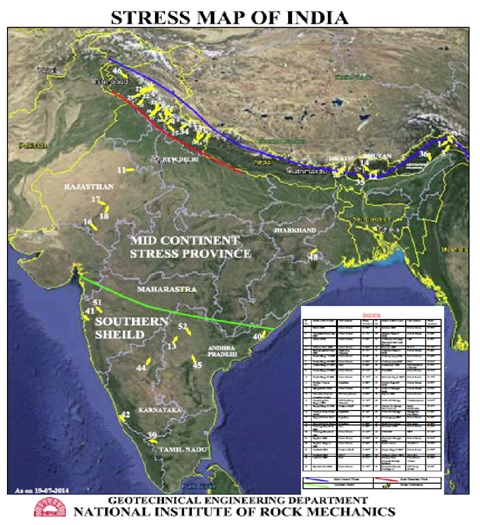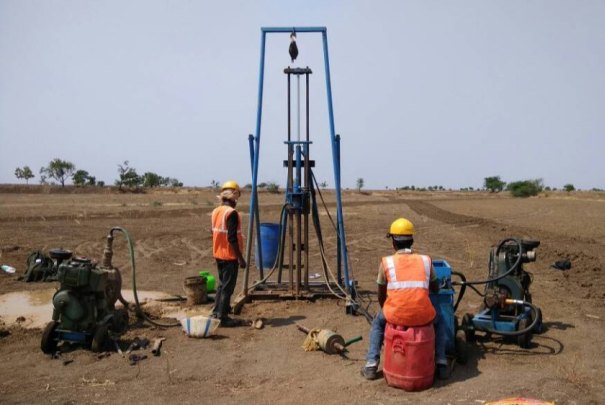The in-situ Geotechnical investigations are an essential and integral part for the design of any engineering structure. Geotechnical engineering department of National Institute of Rock Mechanics (NIRM) with its experienced manpower and state of the art equipment is actively involved in numerous projects both in India and its neighbouring countries. Around 211 sponsored projects in different areas of construction viz. hydroelectric, irrigation, railway, mining, petroleum, atomic and nuclear sectors were completed in the last 30 years of the establishment of this Division at NIRM.
The in-situ geotechnical investigations carried out are viz.,
- In-situ stress parameters determined by Hydrofracturing technique (HTPF method) up to 600m depth from the surface
- In-situ deformability parameters determined by Plate load test method and Plate jacking method as per ISRM and ASTM standards.
- In-situ deformability parameters determined by Goodman jack and Pressure meter methods inside the boreholes.
- In-situ direct shear strength parameters for Cohesion and Friction angle of rock mass
- Plate bearing capacity and Foot load tests as per ISRM and IS standards
- Modulus of Subgrade Reaction of Soil as per ISRM standards
- Acoustic Borehole Tele viewer to scan the boreholes up to the depth of 600 m for studying the various features of rock mass.
In-situ stress
The distribution of In-situ stresses in terms of magnitude and orientation affects the geometry, shape, dimensioning, excavation sequence and orientation of underground openings/mines. Some of the design solutions in hydroelectric projects require in-situ stress measurements depending on the ability of the rock formation to support the excavation, the acceptable water pressure in the conduits and best orientation for different components of the powerhouse complex. In room and pillar mining, stresses in pillars affect the overall mine extraction ratio, the overall mine stability and layout. In the petroleum industry borehole stability is controlled by stress concentrations along the borehole walls. The in-situ stress field is also important for fracturing the formations of oil and gas fields to enhance the production. Hence the Knowledge of in situ stresses is fundamental to many studies in earth sciences.
The Geotechnical Engineering Department of NIRM has vast experience in this field and stress measurements were conducted for the needs of industry for the last 28 years. The significant achievements are highlighted as under.
Highlights
- The Stress Map of India has been prepared and periodically updated for quick and reliable information regarding stress directions at various places of India. This is a significant contribution towards the World Stress Map. The database that is available from Stress map of India will not only be helpful in academic research but also for commercial and economical investigations. In academic research, this data will contribute to knowing the possible movement of plate tectonics.
- A new technique has been developed to measure the in-situ stresses using manipulation of flow rate in fractured and porous rock mass. This technique would be helpful in conducting the stress measurements in fractured rocks especially in Himalayan terrains where the rock mass is generally porous or highly fractured.
- Due to the highly fractured nature of the joints in the Himalayas, the normal hydro fracturing tool is ineffective due to the longer length of the injection unit of the hydro fracturing tool, and a special site specific hydrofracture tool is designed and developed as an innovative method to address this problem.
- Online, real time mobile app has been introduced to know the quick result of magnitude and direction of stress in the field itself.
- Stress measurements are conducted at various hydroelectric project sites at the depth of 350 m from the surface at Himalayan areas and at 600m depth from the surface in Coal mines.
- The Geotechnical Engineering Department of NIRM has applied for obtaining Patent rights from Controller General of Patents, Designs & Trademarks, Govt. of India for the following and the content has been published along with preliminary examination.
- In-situ stress measurements in fractured rock mass by using high flow rate technique.
- In-situ stress measurements in porous rock mass by using high viscous liquid.


In-situ deformability parameters
The in-situ modulus of deformability (Em) is one of the engineering properties of rock mass. It is a basic input parameter used for the design of underground excavations viz., caverns, tunnels, shafts and foundations viz., dam, powerhouse and ventilation stack. The plate-load/plate jacking test is one of the most common methods to determine the deformability of rock mass in-situ. In this method, a load is applied to a specially prepared flat surface by means of a rigid or semi rigid finite plate and measuring the deformation at any convenient point within the rock mass. Thus, rock modulus can be calculated using the relationships developed depending on the shape of the loading plate and nature of the rock. The Geotechnical Engineering Department of NIRM is having vast experience in this field to conduct these tests in-situ.


In-situ direct shear parameters
The in-situ shear parameters (cohesion and internal friction angle) is one of the engineering properties of the rock mass. It is a basic input parameter used for the design of underground excavations viz., foundations and dams etc. Shear parameters of rock mass and concrete-rock interface are important parameters required for the design of the dam and in the evaluation of its stability against sliding. Another key requirement is the shear strength of foundation joints and discontinuities. These shear strength parameters cannot be predicted based on case histories and on any classification system. Therefore, it is important to measure them in-situ at each site, particularly due to variation of rock mass properties at different sites. The shear strength of rock depends upon a number of factors such as strength of rock, rock type, joint pattern, rate of loading, rate of shearing etc. The Geotechnical Engineering Department of NIRM is having vast experience in this field to conduct these tests in-situ.


In-situ Modulus of subgrade reaction of soil (K-VALUE)
The modulus of subgrade reaction of the soil in place usually known as K-value of sub-grade is essentially a plate bearing test for evaluation of strength of subgrade for roads, runway pavements and raft foundations. The Modulus of subgrade for soils of backfilled or overburden material are generally determined by plate bearing method. The Geotechnical Engineering Department of NIRM is having vast experience in this field to conduct these tests in-situ.

In-situ safe bearing capacity
The bearing capacity of foundations is needed for dimensioning the foundation for any structure. The safe bearing capacity may be defined as the “Maximum intensity of loading that the foundation will safely carry without the risk of shear failure of soil irrespective of any settlement that may occur”. The knowledge of behaviour of soil (or) any foundation material upon loading can be studied in-situ by carrying out plate load test (or) foot load tests. The ultimate bearing capacity and safe bearing capacity are essential for the design of foundations. Considering the large size of aggregates involved, foot load tests are best suitable. Steel plates are not of much use because of seating difficulties. Best results are obtained with cast in-situ concrete blocks or with precast blocks, set with fresh mortar, so that there is perfect bond between the soil and the block. The Geotechnical Engineering Department of NIRM is having vast experience in this field to conduct these tests in-situ.

High resolution Acoustic Borehole Tele viewer Logging
High resolution Acoustic Borehole Tele viewer logging is used to measure several physical properties of the geological formations intersected by boreholes. The information gained may then be employed to determine the geometry of major subsurface structural discontinuities and to estimate the mechanical properties of the formations surrounding the borehole. The Geotechnical Engineering Department of NIRM is having vast experience in this field to conduct these tests in-situ.

Authored by –

About the author
Dr DS Subrahmanyam is the Head of the department for Geotechnical Engineering Division, National Institute of Rock Mechanics. He is associated mainly with the geological and geotechnical studies of many important engineering projects in the Himalayan region and presently responsible for planning, programming, implementation and monitoring of engineering geological/geotechnical investigations of hydropower projects, communication projects, underground storage plants, underground mines and irrigation projects in India and abroad. He established an innovative technique for conducting stress measurements in fractured and porous rocks for which he is going to get the Patent rights from Controller General, Patents & Designs (India). He is credited with preparing the Stress Map of India for contribution to the World Stress Map.
He has authored more than 60 papers to his credit, published in National and International journals and proceedings and nearly 120 Technical reports and 5 Research projects submitted for various assignments. He is also the Fellow and life member for various National and International societies and associations. He is Editor for 7 International journals and Reviewer for various National and International Magazines. He visited Finland, Sweden, Singapore, Bhutan and Nepal in connection with the Project related works and seminars.

